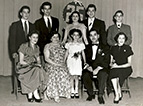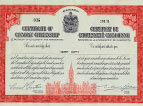Italian Canadians Today
[The] actions [of the Italian government] threw the Italian community of Toronto into a most unfavourable and unjust light. However, the subsequent action of Canadians of Italian extraction in Canada during the war was a sufficient answer to their critics. They proved themselves to be loyal, reliable and intelligent Canadian citizens, valuable members of the Canadian community.
Arthur W. Roebuck, Liberal Member of Parliament, in a letter to Eliseo Orlando, ex-internee, October 16, 1951
Today, Italian Canadians are a successful group. They are businessmen, skilled professionals, artists and innovators in every field.
Immediately after the war, however, the Italian Canadian community became fragmented. Individuals feared being targeted again by the Canadian government. Those who were affected by the War Measures Act attempted to return to a normal life as quickly as possible. Others anglicized their names to escape the stigma associated with being Italian.
Once released, many of the internees and their families had no choice but to start over. Italian Canadians also had to work to rebuild community organizations.
There were many changes as a result of the massive influx of new immigrants from Italy. In the post-war years, from 1950 to 1970, Canada saw its highest numbers of Italian immigrants yet. Numbering about 500,000, these new Italian Canadians surpassed the number of earlier immigrants. As a result, they began to redefine what it meant to be Italian Canadian.
Although some Italian Canadians were cautious about associating with the “new” Italians, for the most part, the existing community welcomed the new arrivals. By working together, the community benefitted from Canada’s post-war boom and the Canadian government’s approval of the Multiculturalism Act. Italian Canadians became identified with strong family values and a solid work ethic, which played an important role in building the infrastructure of cities and in the construction industry in general. Although Italian Canadians are still challenged by the harmful stereotypes of the past, they have flourished and are now firmly established in Canada.
Post-War Realities
• All internees had their assets administered by the Custodian of Enemy Property. In some cases, an internee's properties and personal belongings were sold at a fraction of their worth. Although some internees were able to return to their jobs, many others had to find new employment.
• The Casa d’Italia buildings were seized by the Canadian government in June 1940. In 1947, the Italian Canadian community of Montreal petitioned successfully to have the Casa d’Italia on Jean Talon St. returned to them. In Toronto, in 1962, after a long battle, the Casa d’Italia on Beverly St. was returned to the community. The Order Sons of Italy lodges re-convened, but many former members were afraid to rejoin the organization, fearful that their membership in such a group might again be used against them.
• After their homeland was torn apart during World War II, many Italians migrated to escape poor economic conditions. The post-war immigrants gravitated to the existing Little Italies, which provided a place where they could meet other Italian newcomers. They were able to maintain their culture and traditions. And a new language was born: Italiese is the blend of Italian and English. By 1980, the Italian Canadian community had become one of the largest in Canada after the English and French Canadian. The majority of these new immigrants settled in the Greater Toronto Area, thereby shifting the base away from Montreal, which had had the largest Italian community in Canada prior to the war.



